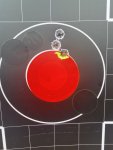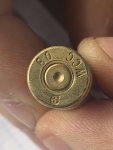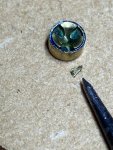The Rodney
Senior Member
Started reloading all of two weeks ago and am off on a long journey, I really like this.
Rough start with CFE 223 and Sierra TMK shooting five inch groups and one 4" trying four charges and three seating depths. The Hornady Match did better but no tighter than 3" @ 100 yds.
Frustrated about all this I played it al back in my head. I mounted the scope to torque specs so no issue. Must be mistakes at the reloader but I am shooting box ammo with wild fliers and four to five inch groups. Must be my marksmanship, well? Been a solid rifle shot a long time. Did you check torque on your actions screws.... no. Loose. Torqued to 30" on the front and 50" on the rear with new loads to test. Lee starting loads for TMK. Nope.... fliers and 4" groups. Dang. Hornady Match 2" group with two different charges! Well, that made happy. Then Hornady SST and the pic speaks for itself. I am through with TMK till I get another powder. One charge on SST showed some stress on the brass face so will shoot the lesser charge which is a full grain down. Will try some higher charges with Match and hopefully get to 1". Two screws man..... so simple!
Rough start with CFE 223 and Sierra TMK shooting five inch groups and one 4" trying four charges and three seating depths. The Hornady Match did better but no tighter than 3" @ 100 yds.
Frustrated about all this I played it al back in my head. I mounted the scope to torque specs so no issue. Must be mistakes at the reloader but I am shooting box ammo with wild fliers and four to five inch groups. Must be my marksmanship, well? Been a solid rifle shot a long time. Did you check torque on your actions screws.... no. Loose. Torqued to 30" on the front and 50" on the rear with new loads to test. Lee starting loads for TMK. Nope.... fliers and 4" groups. Dang. Hornady Match 2" group with two different charges! Well, that made happy. Then Hornady SST and the pic speaks for itself. I am through with TMK till I get another powder. One charge on SST showed some stress on the brass face so will shoot the lesser charge which is a full grain down. Will try some higher charges with Match and hopefully get to 1". Two screws man..... so simple!




